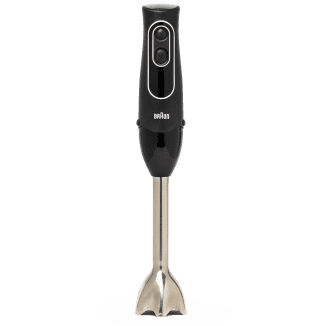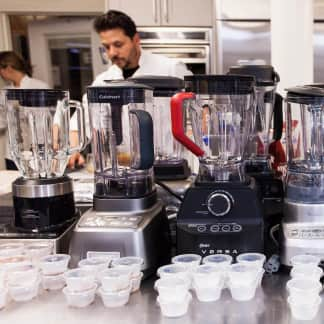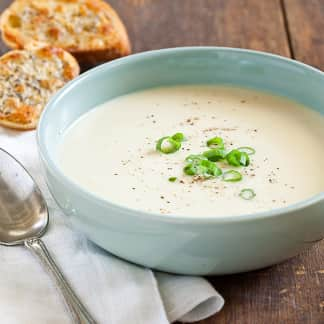The best immersion blenders are great for blending hot soups on the stovetop and can also blend frozen fruit for smoothies and even emulsify mayonnaise. Our winner, the Braun MultiQuick 5 Hand Blender, is lightweight and compact. We love its satisfyingly simple controls and impressive pulverizing ability. It’s also considerably less expensive than many models on the market.

Anyone who has pureed hot soup in a countertop blender knows it can be a hassle. It often has to be done in batches, which requires an extra pot or bowl. You also have to let the soup cool down a little so that pressure doesn't build up inside the blender and cause the lid to pop off. But the best immersion blenders (also called hand blenders or stick blenders) get the job done efficiently, tidily, and safely; all the blending is done directly in the pot. You can also use them for many of the tasks you’d lug out your regular blender for, including crushing ice and making frozen cocktails, emulsifying salad dressings, and blending sauces and marinades. They’re also generally easier to clean and store than countertop blenders, and they often cost less.

Each immersion blender consists of the same two components: a cylindrical handle that houses the motor and controls and a blending shaft that is usually detachable. On one end of the blending shaft sits a blade housed in a cup-shaped guard. A handful of models are cordless and are rechargeable using charging cables or docks. Some models also come with whisk attachments, plastic blending jars, and even chopping chambers with extra blades that look like small food processor bowls. Interested in what factors make the best immersion blenders, we tested a lineup of models, including their extra attachments when available.
What to Look For
- Simple, Intuitive Controls: We preferred models with one or two easy-to-interpret power buttons that required only one hand to use. Our favorites had two buttons for two simple speed options or single buttons that adjusted the speed as we increased or decreased pressure.
- Fewer Speed Options: The best models had only a few (two to four) speed options. Fewer speeds made blending more efficient; instead of wasting time choosing between up to 15 speeds, we could pick from just a few and save ourselves the hassle.
- Comfortable Grips: Our favorite handles had well-designed grips that comfortably fit many different hand sizes. They were 5.5 inches in circumference or less, and they were coated in soft, grippy plastic or silicone to prevent slipping.
- Lightweight, Compact Construction: Operating any immersion blender for a substantial amount of time can be tiring, but lighter models kept us from fatiguing too quickly. We preferred models that weighed around 2 pounds or less. We also liked the shorter models in our lineup, which positioned our hands closer to what we were blending and felt less unwieldy. Our favorites were 15 or 16 inches long—still long enough to reach the bottom of a large pot filled with soup.
- Small, Bell-Shaped, Ventless Blade Guards: The blade guards of all the models we tested had ridged or scalloped edges that allowed ingredients to flow around the blade; some of these blade guards also had vents or holes. Bell-shaped blade guards allowed food to flow freely around the guard instead of getting trapped on top in narrower containers. Blade guards that were no more than 2.5 inches in diameter fit well in all the containers we tried them with. Additionally, blade guards without vents or large holes kept food from splattering.

Nice to Have
- Flexible Cords: Some of the corded models had stiff, unyielding cords that constrained us and made maneuvering the blenders uncomfortable. We preferred flexible cords that allowed us to angle and reposition the blenders as we saw fit.
- Easy Eject Mechanisms: Clearly marked eject buttons were a nice plus. All we had to do was press lightly on these buttons to eject the blending shaft instead of wrenching and twisting the shaft to detach it.
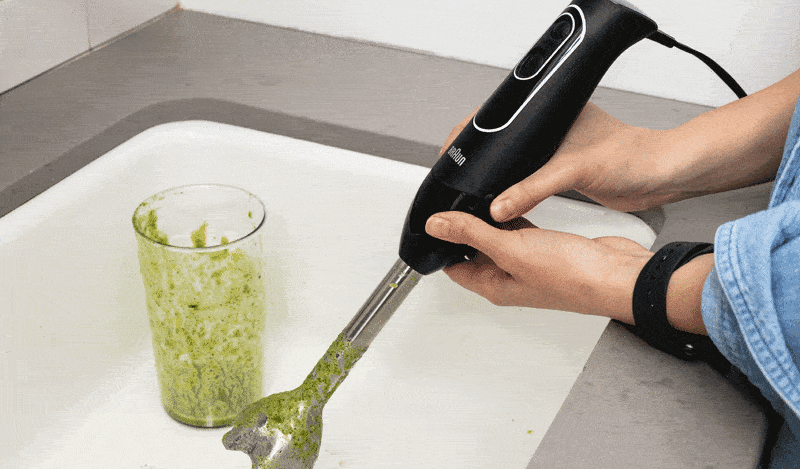
- Dishwasher-Safe Blending Shafts: It was convenient to simply detach a blending shaft, quickly rinse it in the sink, and place it in the dishwasher instead of having to scrub it by hand. We also found this much safer than scrubbing the sharp blade with a sponge.
What to Avoid
- Complicated Controls and Safety Locks: We found the controls of several models to be confusing and unnecessarily complicated. Some had speed dials on the tops of their handles that required us to use both hands to operate, taking our focus away from what we were blending. Others had locking safety mechanisms that prevented us from turning on the blenders unless we pressed an unlock button. The most tedious of these required us to press the unlock button every time we resumed blending—even after brief pauses.
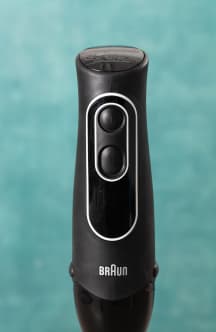
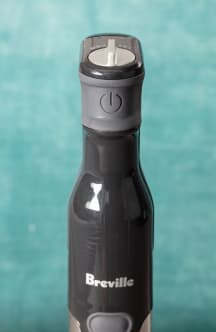

Some blenders had speed selection knobs on the tops of their handles (center) that forced us to pause and use both hands while blending. Others had pesky unlock buttons designed for safety (right) that required us to press them every time we began to blend or resumed blending. The best models had simple buttons without bells and whistles that we could control with one hand (left).
- Too Many Speed Options: Some models offered more than five speed options (one offered 15). With most of these models, we saw little difference between the speeds at the lower end of their ranges. It was time-consuming and a bit frustrating to scroll through all the extra speeds when other models offered fewer options with fewer buttons to select them.
- Heavy, Bulky Designs: Heavy, bulky blenders fatigued our arms faster. Longer models placed our hands far away from the action, rendering the blenders awkward and difficult to maneuver.
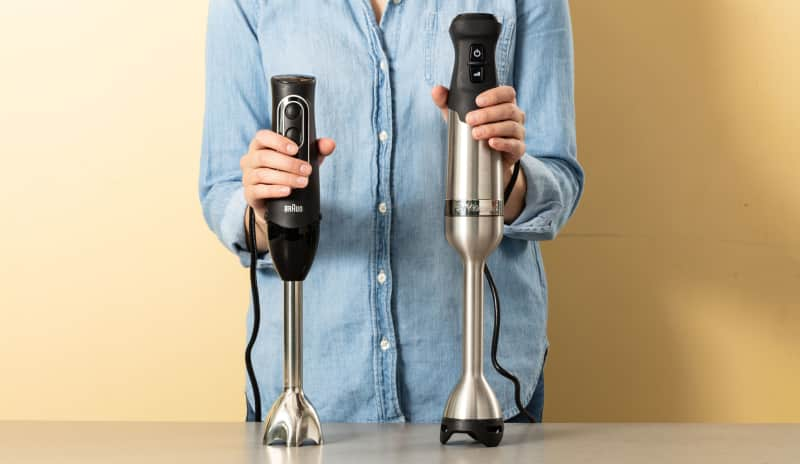
- Short, Flat Blade Guards: Flatter blade guards with sides that angled downward at 90-degree angles were especially frustrating in narrower vessels. They trapped food above their exteriors and kept it from flowing freely and getting processed.
- Blade Guards with Vents: Vents in the blade guards were meant to help food circulate, but they merely provided gaps for whatever we were blending to be flung out of the guards if they weren’t fully submerged. The vents were positioned high up on the blade guards, which made it easy to accidentally uncover them if we even slightly tilted the blenders. The result? Splattered food.
Other Considerations
- Cordless Models: We liked how convenient the cordless models were to use; no cords meant that we were free to blend anywhere we wanted. Unfortunately, every cordless model in our lineup performed poorly for other reasons. They were all too heavy or had such overly complicated controls that we can't recommend any of them. They also can’t operate while charging, so if you forget to charge them before you want to blend, you’ll be out of luck.
The Tests
- Blend potato soup in a Dutch oven
- Blend kale and pineapple smoothiesin blending jars (or quart-size deli containers when applicable)
- Emulsify mayonnaise in blending jars (or quart-size deli containers when applicable)
- Make whipped cream in large metal bowls, using whisk attachments when applicable
- Chop onions with models that included chopping jars
- Have additional testers use the blenders and note their thoughts
- Attach and detach the blending shaft 50 times
- Wash the attachments by hand and wipe down the blender bodies throughout testing and additional times, for a total of 10 washings
- Winner only: Blend 25 smoothies one after another to assess durability
How We Rated
- Controls: We evaluated how simple the controls were to understand and operate.
- Comfort and Handling: We assessed whether the blenders were comfortable to hold and operate and how easy they were to maneuver.
- Blending: We tested how effectively and efficiently the models blended food, noting the texture of the final product and whether the blenders splattered during blending.
- Cleanup and Durability: We evaluated how easy the blenders were to clean and how well they held up to repeated use and cleaning.

